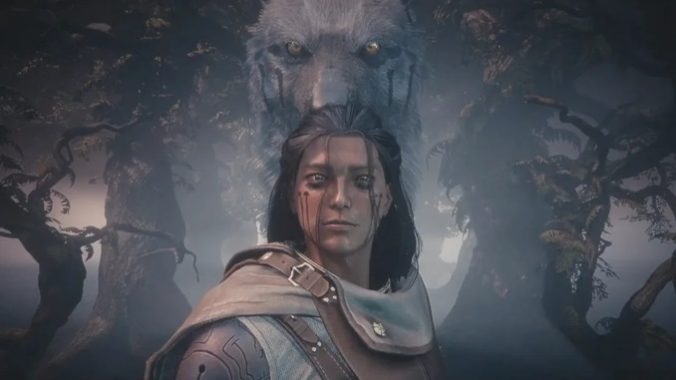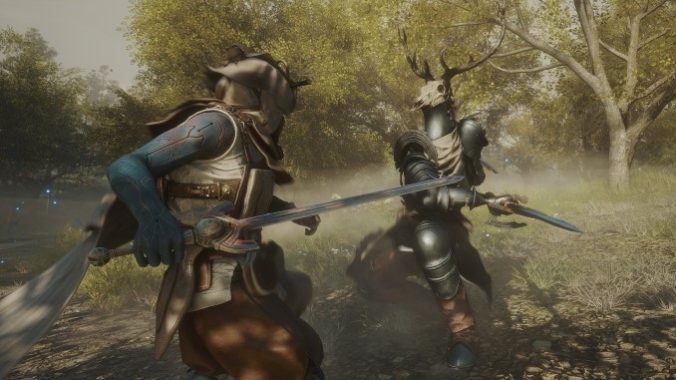Inside Soulframe, the “Earthy and Romantic” New Fantasy RPG from the Makers of Warframe
Games Features Soulframe
Digital Extremes, the studio behind the now massive ongoing game Warframe, has been hard at work on something new for the last several years. Going by the name Soulframe, this project was initially teased as a “mirror universe” to the studio’s ongoing efforts in their existing game, but when I recently got to see it in action, it couldn’t have appeared more different. While still bearing some of the hallmarks of Digital Extremes’ major work, it carved a path entirely of its own. The first thing I asked Steve Sinclair, the chief creative officer at Digital Extremes and the director of Soulframe, was about how well that “mirror universe” statement was holding up these days.
“I don’t want to make a copy of Warframe or a clone of Warframe. Some of the things that you would recognize from Warframe—the persistence, it’s free, it’s PVE focused, it’s co-op focused…The structure of the kind of framework of the game is in essence a mirror. But you’re right, it is a reflection in a way that it’s opposite than it is kind of a twin, isn’t it,” Sinclair explained. “And so where Warframe is crazy fast, Soulframe is much, much slower. Where Warframe is gritty and industrial, Soulframe is earthy and romantic.”
And it’s true. Over the years, I’ve gleaned bits and pieces of Warframe. First pitched to me by friends when it was a debut title on the PlayStation 4, I’ve always associated the game with the extreme agility of the onscreen cyber ronin that players control. Every time I saw a Warframe clip or stream, the environments turned to a blur as the player character darted past enemies and levels. I’d never even seen gunplay until the live demo I received of Warframe‘s future expansions when I visited the studio during Tennocon 2023. And while I know folks who’d swear by that game, it wasn’t that it wasn’t up to my speed, but rather that I wasn’t up to its speed. And how could I be, as it blew past my expectations at Mach 5 and became one of the longest running and most successful live service games of this generation and the last? Warframe had withstood the test of time, and now it was time for Digital Extremes to build something new. It sounds like it’s been a welcome reprieve from the ceaselessness of life as a Tenno.
Soulframe has fundamentally revolutionized how the team perceives combat and spaces. When I asked about the ways in which that has manifested, Sinclair pointed to the very demo we’d seen live. At a certain point, an enemy begins approaching the player. In Warframe, as Sinclair put it, combat is rapid fire, consisting of “nuking and killing 20 to 30 enemies sometimes at the same time.” By comparison, this lone enemy was a threat that the demo player was able to dispatch by methodically tossing their sword at a trap above them. Sinclair continued, “To use my bad mirror analogy, by inverting the speed and inverting someone’s emphasis, it’s really been interesting to say, ‘Oh, okay, now we have time to think even when we’re fighting a single enemy. I can see what he’s doing and have time to think about it and it creates a different design space that’s kind of refreshing to work in.’”
Warframe being a project 10 years deep also makes it difficult to add to it without potentially breaking things. The freedom from those constraints, and the threat of breaking people’s games or ruining their investments in their Tenno, has been another liberating aspect of working on Soulframe. “There are times in history where in Warframe we tried things like, ‘Okay, let’s add more physics to the game.’ But in Warframe, you’re just flying through these levels, and it’s kind of irrelevant,” Sinclair said. Starting from scratch on Soulframe has opened up the possibility for systems as benign but slyly complex as physics to have a place in a game where it actually fits. And once again, a slower game has led to further investments from the team in how cooperative play works. Sinclair noted how difficult it is to promote synergies between players in Warframe, where every decision is a snap decision, and how Soulframe creates time and space for players to combine skills for more potent effects. He noted in particular how, when the team was rehearsing the demo the night before its big reveal, the team members on the sticks were making decisions with others in mind, like rendering enemies into statues so another player could follow up with a heavy attack that’d reduce them to pieces. It isn’t that Warframe doesn’t have synergies players can exploit, but that there’s a mindset that has solidified over years of reinforcement that’s hard to erode or change without making waves. Soulframe lets this more experienced team bake that in from the very beginning and craft an experience around it.

This is also reflected in Soulframe‘s genre. The team would describe it as an RPG first and a multiplayer action-driven loot game second, whereas with Warframe it worked in reverse. The RPG elements of Warframe were added over time, and were well received, but the team has had to fight to “wedge” those in. Soulframe doesn’t have to jump through those hurdles. Sinclair has especially always held that the game would be an RPG and lit up as I asked him about his favorite mechanics and features that Soulframe would boast. Considering how hot our conversation was coming off the initial release of Baldur’s Gate 3, he couldn’t help but cite the reactivity of the world and the ability to change it with dialogue choices, which have appeared in Warframe, but are much more fundamental to Soulframe‘s construction.
The core of Soulframe is rooted in another body of work, though. In our demo, Sinclair stated that the game was “a response to an angry and anxious culture,” which I needed more of an elaboration on. He explained to me that when he was first pitching the game to his creative partner, he knew he wanted a fantasy RPG but needed a greater hook than the straightforward fantasy. “We’re not just gonna give someone knight armor and a sword and just have ’em go whack [things],” he told me. He found inspiration in Hayao Miyazaki’s work—in particular Princess Mononoke—and the “romanticism movement,” and how they represented this longing for the pastoral way of life, while also acting as angry rejections of industrialism. That and the hold that this kind of vituperative mindset Sinclair has observed in the world has on our wider culture made the idea of Soulframe as this kind of escape from it all take shape. Soulframe, which also tackles ancestry in both systemic and thematic ways, also has concerns for how our cultures value its elders, and through our conversation, I could tell that this game was Sinclair’s way of dealing with a lot of anxieties in the world and represented his attempts to heal them in his own way. Or as he put it, “I think it’s ironic to make a game of touching grass ’cause you want people to actually go touch the grass.”
The demo itself centered around a character who harms the ecosystem and the people in it, but is ultimately forgiven after the climactic fight. “I think there’s really interesting themes there that will hopefully every now and then make people think about empathy for the world, empathy for the environment, empathy for each other, redemption of each other.” It begins painting this empathetic picture by showing us visions of her as a child and exposing us to a tune that becomes integral to the eventual boss fight against her and the spirit of a stag that she’s corrupted while under the influence of a faction simply called the Ode. The breathtaking encounter muffled every other sound save for the song from her childhood, and eventually her hum broke into a full song complete with a verse. I’ll admit to giving into the astonishment of it all and hoping that the encounter pointed to an importance in the role of music for Soulframe. Sinclair was all too happy to confirm as much.
“Obviously, music is a huge important component to the game, central to almost everything.” The song in question was actually improvised by the voice actor after getting in the session, and their take was so good that the sound team decided to forgo anything that could get in the way, leading to the call to mute the sounds of the fight. Music is just one of several cultural touchstones the team is hoping to build the game around, though. “It will be music, verse, poetry, cooking…These are the things that are gonna wake people out of these spells [when] you appeal to them,” Sinclair explained. You’re going to call back to any aspect of their history or culture—be it personal or be it ancestral—that will snap them out of the spell.” Alongside picking an ancestor, which will decide skills your player will have, you will also pick what Sinclair called a “family instrument” to learn songs on, similar to what players have likely seen in Zelda titles, namely Ocarina of Time.
It’s a huge undertaking to build a new world, history, and cultures to complement entirely new themes, but it’s one Sinclair seems confident in tackling, especially with the experienced team he’s working with. At first blush at least, Soulframe is a familiar, but different kind of game for Digital Extremes, and one that I’m happy to see them try their hand at. If the demo I saw, which represented a year’s amount of work according to them, is any indication, it will be a prominent feather in their cap, as well as proof that the studio isn’t a one trick pony. I, for one, am looking forward to seeing Soulframe come to fruition.
Moises Taveras is the assistant games editor for Paste Magazine. He was that one kid who was really excited about Google+ and is still sad about how that turned out.